|
Report from
North America
Sawn tropical hardwood imports fell in January but
new commodity codes make it uncertain by how much
The volume of sawn tropical hardwood imported by the
US fell by in January but changes in how the US
government calculates the imports throw some doubt into
the actual amount of the decline.
Beginning with the release of January 2021 monthly trade
data, the US Department of Agriculture adopted the World
Trade Organization¡¯s internationally recognised definition
of ¡°Agricultural Products¡± as its standard definition for
reporting agricultural trade.
New commodity codes for ipe and jatoba imports were
created and appear to be indistinguishable from the former
codes. However, it appears the data for the new codes
have not been included in the January sawn tropical
hardwood imports. As such, the official total reported by
USDA for tropical hardwood imports was 7,662 cubic
metres in January which is a 48% decline from
December¡¯s volume. However, if January¡¯s ipe and jatoba
imports are added that total comes to 13,064 cubic metres,
a drop of only 11%.
Imports of balsa and virola more than doubled in January,
with Balsa imports showing the strongest volume in more
than a year. Imports of keruing fell 60% in January to
their lowest volume since 2012.
Canada¡¯s imports of sawn tropical hardwood stayed fairly
level in January, falling just over 1%.
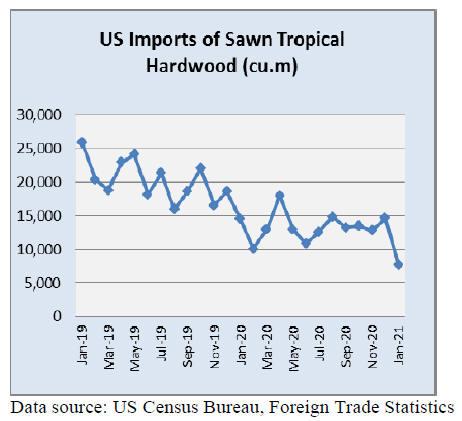
Hardwood plywood and veneer imports fell in January
US imports of hardwood plywood fell by 5% in January
from December¡¯s volume to a level 8% less than that of
January 2020. January Imports were down sharply from
Malaysia and China with volume dropping 60% from
Malaysia and 57% from China.
Imports from both countries were more than 60% less than
that of the previous January. Imports from Indonesia and
Ecuador were down 14% and 10%, respectively, while
imports from Russia were up 15%.
US imports of tropical hardwood veneer fell for the third
straight month in January, declining 39% to the lowest
level in more than five years. January imports were down
48% from January 2020.
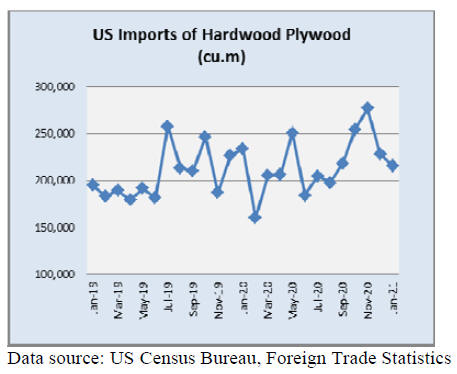
The decline was due to there being noveneer imports from
Italy, the top supplier to the US. This also occurred in
September 2020. Meanwhile, imports from both India and
China were up sharply, but still did not reach the levels of
the previous January.
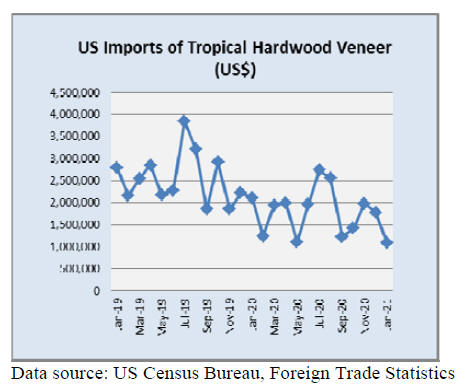
Strong start to year for hardwood flooring
US imports of hardwood flooring got off to a strong start
in 2021 as imports rose 25% in January. Imports for the
month from China more than doubled and imports also
rose sharply from Indonesia (32%).
Imports from Brazil were up 47% in January and were
also 47% better than the previous January. Total January
imports were 23% higher than January 2020.
US imports of assembled flooring panels showed similar
strength, gaining 23% in January over December 2020.
Imports from Thailand more than doubled in January and
were 40% ahead of the previous January. Imports from
China, Canada, and Vietnam also surged in January and
significantly outdid totals for the previous January.
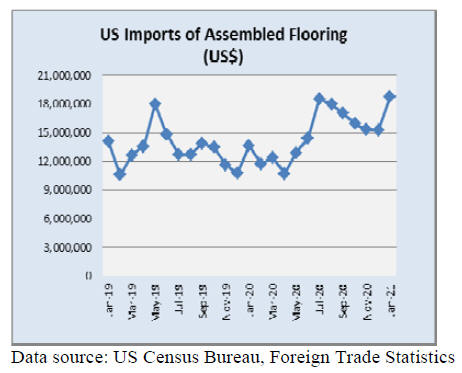
Moulding imports bounce back
US imports of hardwood mouldings rose 20% in January
to a level not seen since July 2020 but were still 8% less
the imports from the previous January.
Imports from China doubled in January while imports
from Brazil were down by 34%, both were down more
than 40% from last January. Imports from Canada grew
9% in January and were 10% higher than in January 2020.
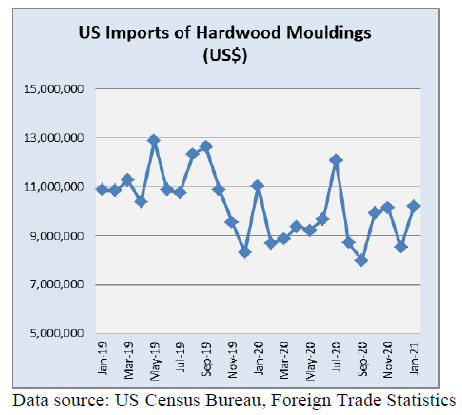
Growth in wooden furniture imports continues
US imports of wooden furniture continued a growth
streak, rising for the eighth straight month, up 2% in
January. Imports rose above US$2.1 billion for the month
as imports from most countries showed steady growth.
Imports from Vietnam and Canada both rose 6% while
imports from Indonesia rose 5%. Due to the steady
growth, imports from Vietnam were 45% higher than
January 2020. Total imports of wooden furniture were up
27% in January over the previous year.
The overall residential furniture market continues to grow
but has slowed somewhat according to the Smith Leonard
Furniture Insights report. Furniture orders slowed from
increases of more than 40% to a 17% increase in the
November 2019 to November 2020 comparison while
December 2020 orders were up 27% over December 2019.
Some 84% of survey participants reported increased orders
for the month. The increase in December brought total
orders for the year to 15% over those of 2019.
Shipments in December were only up 5% over December
2019. The increase in December resulted in a decrease in
shipments for the year of 6%. Approximately 78% of the
participants reported declines in shipments for the year.
See:
https://www.smith-leonard.com/2021/01/28/january-2021-furniture-insights/
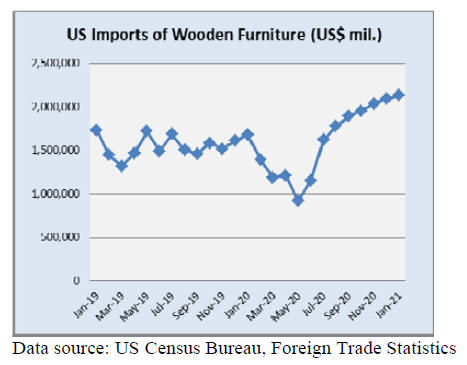
Despite dip, cabinet makers report solid sales
Cabinet manufacturers reported an increase in overall
cabinet sales of 10.4% for January 2021 compared to the
same month in 2020 according to the Kitchen Cabinet
Manufacturers Association¡¯s (KCMA) monthly Trend of
Business Survey. Among survey participants, custom sales
are up 7.8%, semi-custom increased 17.7%, and stock
sales increased 6.1%.
When looking at the month-to-month comparison, cabinet
sales dipped. Overall sales were down 2.9% in January
2021 compared to December 2020. Custom sales
decreased 7.1%, but semi-custom sales rebounded to up
5.0%, while stock sales decreased 7.3%.
See:
https://www.kcma.org/news/pressreleases/january_2021_trend_of_busines_press_release
Circumvention finding on radiata/agathis pine plywood
overturned
In February this year the US Court of International Trade
overruled the finding by the US Department of Commerce
that imports of plywood with face and back veneers of
radiata and/or agathis pine from China are circumventing
the antidumping and countervailing duty order on
hardwood plywood.
As a result of the ruling the Department of Commerce has
until April to file a new determination finding, though it
could seek an extension of this deadline.
See:
https://www.cit.uscourts.gov/sites/cit/files/21-19.pdf
 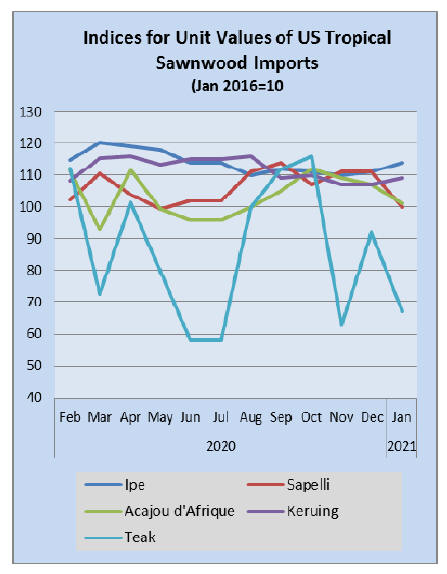
In January 2021, the commodity codes for ipe and jatoba were
redefined in the Harmonized Tariff System and adopted by the
US. Periodically, commodity codes are replaced, redefined or
recategorized.
These codes become obsolete and are replaced by
new codes.
|